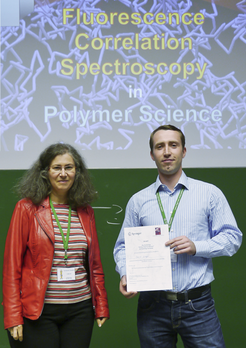Dual-color correlation spectroscopy makes equilibria visible

David Schäffel, PhD student at the Max Planck Institute for Polymer Research (MPI-P) was honored for his talk on dual-color fluorescence cross-correlation spectroscopy (DC FCCS) at the conference "FCS in Polymer Science". The conference addressed the topic of application of fluorescence correlation spectroscopy (FCS) in polymer physics; this took place in Garching nearby Munich from October 10th to 11th 2013.
FCS is an optical method that monitors the diffusion of fluorescently labeled molecules or particles to determine their concentration and size. In Schäffel’s presentation "FCCS directly monitors coalescence between nanodroplets and the dynamic equilibrium exchange kinetics of copolymer micelles", he describes how supramolecular structures from block copolymers behave in thermodynamic equilibrium. Block copolymers are made up of two or more different monomers which – depending on their chemical structure – may display different properties. If one of the parts (blocks) is hydrophobic and the other hydrophilic then supramolecular structures can form in solvents in which only one block is soluble. So-called micelles can, for instance, be formed in water where the hydrophilic blocks shield the hydrophobic ones from water. Although the micelles are stable and in equilibrium there still can be a constant exchange of copolymers between the micelles.
David Schäffel and project leader Kaloian Koynov used DC FCCS to measure this dynamic process. They used two fluorescent dyes with different colors to label the micelles respectively. Subsequently, they observed the transition from single-colored micelles to dual-colored ones and drew conclusions about the dynamics of the copolymer exchange.
The exchange kinetics was studied at different temperatures and with different solvents. With their work Koynov and Schäffel were able to show that with respect to studies of the dynamic equilibrium of copolymer micelles, DC FCCS is an appealing alternative to the far more costly neutron scattering methods.












